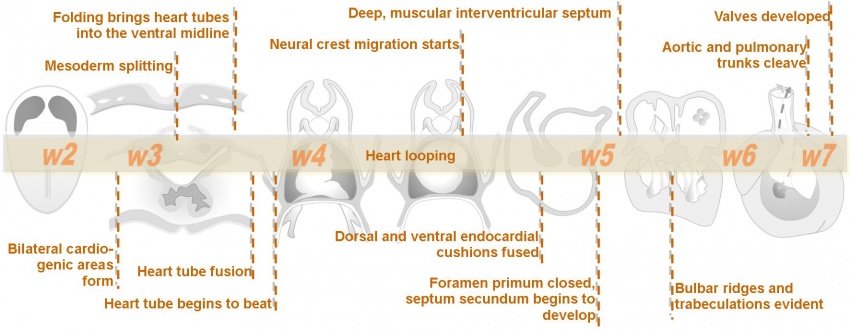Intermediate - Vascular Overview: Difference between revisions
| Line 38: | Line 38: | ||
===Fetal Circulation=== | ===Fetal Circulation=== | ||
[[Image:HeartILP_draft_foetalcirc.jpg|thumb|right|upright=2| | [[Image:HeartILP_draft_foetalcirc.jpg|thumb|right|upright=2|Fetal circulation]]Fetal circulation consequently differs from the adult one predominantly due to the presence of 3 major vascular shunts: | ||
*Ductus venosus - between the umbilical vein and IVC | *Ductus venosus - between the umbilical vein and IVC | ||
*Foramen ovale - between the right and left atrium | *Foramen ovale - between the right and left atrium | ||
Revision as of 15:02, 6 November 2009
| Begin Intermediate: | Primordial Heart Tube | Heart Tube Looping | Atrial Ventricular Septation | Outflow Tract | Heart Valves | Cardiac Abnormalities | Vascular Overview |
| Cardiac Embryology | Begin Basic | Begin Intermediate | Begin Advanced |
Some understanding of embryonic vascular development is helpful in a study of cardiac embryology and the embryonic circulation. Early in the third week of embryonic development vasculogenesis begins whereby endothelial cell precursors form aggregations as angioblastic cords. This process underlies the initial formation of the endocardial heart tubes as well as the primitive blood vessels. The cords coalesce to form blood vessels while continued angiogenesis, driven by metabolic requirements and specifically hypoxia, allows for the creation of a vascular network.
Development of Arteries
Upon folding of the embryo the paired dorsal aortae connecting to the cranial end of the heart tube are brought ventrally to form the first aortic arches. Additional aortic arches develop over the next few weeks which are later remodelled to form the arteries of the upper body. Caudal to the arches, the paired dorsal aortae fuse to form a single median dorsal aorta which develops the following branches:
- Ventral (gut) branches - derived from the vitelline arteries
- Lateral branches - supply retroperitoneal structures
- Dorsolateral branches (intersegmental arteries) - supply the head, neck, body wall, limbs and vertebral column
Development of Veins
Three paired veins drain into the primordial heart tube:
- Vitelline veins - return poorly oxygenated blood from the yolk sac
- Umbilical veins - carry well-oxygenated blood from the primordial placenta
- Common cardinal veins - return poorly oxygenated blood from the body of the embryo
The vitelline venous system gives rise to the liver sinusoids and portal system and forms the ductus venosus which acts as a shunt from the umbilical vein to the IVC. The IVC is formed during a left-to-right shift in the embryonic veins and is composed of:
- A hepatic segment - from the hepatic vein and sinusoids
- A prerenal segment - from the right subcardinal vein
- A renal segment - from subcardinal and supracardinal anastomosis
- A postrenal segment - from right supracardinal vein
The following two diagrams give an overview to the embryonic vasculature:
File:HeartILP draft embryoniccirc.jpg The three embryonic circulations |
Fetal Circulation
Fetal circulation consequently differs from the adult one predominantly due to the presence of 3 major vascular shunts:
- Ductus venosus - between the umbilical vein and IVC
- Foramen ovale - between the right and left atrium
- Ductus arteriosus - between the pulmonary artery and descending aorta
The main function of these shunts is to redirect oxygenated blood away from the lungs, liver and kidney (whose functions are performed by the placenta).
Oxygenated blood is carried from the placenta to the foetus in the umbilical vein, most of which then passes through the ductus venosus to the IVC while some blood supplies the liver via the portal vein. Blood from the liver drains into the IVC through the hepatic veins. The blood in the IVC is a mixture of oxygenated blood from the umbilical vein and desaturated blood from the lower limbs and abdominal organs (e.g. the liver). This blood enters the right atrium where most of it is directed to the left atrium through the foramen ovale and from here to the left ventricle and aorta. The remainder of the blood in the right atrium passes with blood from the SVC (from the head and upper limbs) to the right ventricle and pulmonary artery where most of it passes to the aorta via the ductus arteriosus. The blood passes from the aorta to the hypogastric arteries, umbilical arteries and then back to the placenta.
| Back to Abnormalities | Next: Begin Advanced Module | |
| Go to this section in the basic level |

